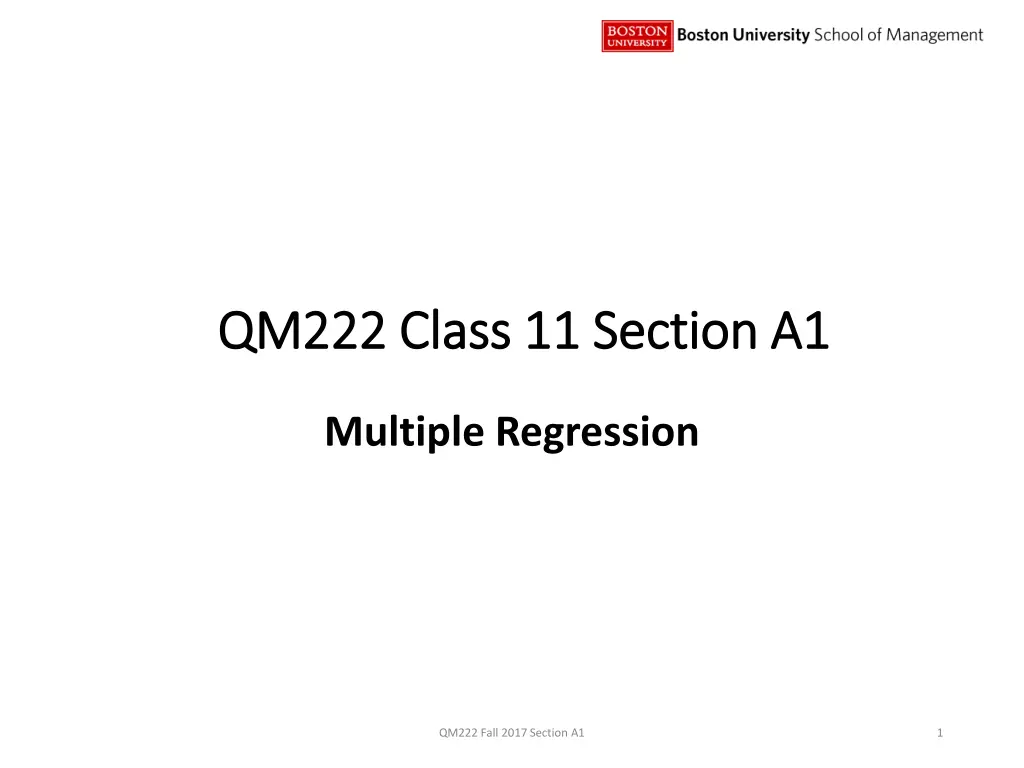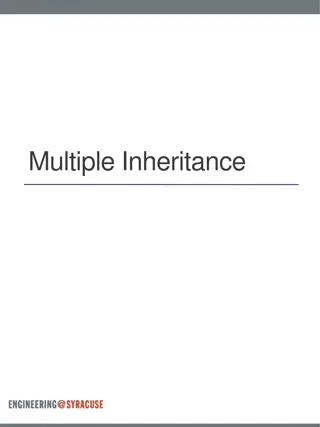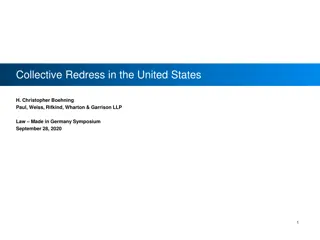
Interpreting Regression Coefficients and Standard Errors
Explore the process of interpreting regression coefficients and their associated standard errors in the context of multiple regression analysis. Understand the significance of standard errors, confidence intervals, t-tests, and p-values in determining the reliability of coefficient estimates. Dive into discussions on potential confounding factors and the utility of multiple regression analysis in statistical modeling.
Download Presentation

Please find below an Image/Link to download the presentation.
The content on the website is provided AS IS for your information and personal use only. It may not be sold, licensed, or shared on other websites without obtaining consent from the author. If you encounter any issues during the download, it is possible that the publisher has removed the file from their server.
You are allowed to download the files provided on this website for personal or commercial use, subject to the condition that they are used lawfully. All files are the property of their respective owners.
The content on the website is provided AS IS for your information and personal use only. It may not be sold, licensed, or shared on other websites without obtaining consent from the author.
E N D
Presentation Transcript
QM222 Class 11 Section A1 QM222 Class 11 Section A1 Multiple Regression QM222 Fall 2017 Section A1 1
To To- -dos dos Have you signed up for your first URO? Do it today. Today All day, office hours except 3:15:4:30. Sign up for 15 minute slots if I said we should speak: https://docs.google.com/a/bu.edu/spreadsheets/d/188IrHsjGhE758eIQ1Jcru-1WGKFmJJYrmD1ppcdcMhY/edit?usp=sharing QM222 Fall 2017 Section A1 2
Today we Today we Review how to interpret the statistics about regression coefficients (listed in the same line as the coefficient itself). Standard errors 95% confidence intervals t-tests p-values Multiple regression: How to interpret it and why use it. Break into groups to talk about possible confounding factors QM222 Fall 2017 Section A1 3
Standard errors of coefficients Standard errors of coefficients price = 12934 + 407.45 size Source | SS df MS -------------+------------------------------ F( 1, 1083) = 3232.35 Model | 5.6104e+13 1 5.6104e+13 Prob > F = 0.0000 Residual | 1.8798e+13 1083 1.7357e+10 R-squared = 0.7490 -------------+------------------------------ Adj R-squared = 0.7488 Total | 7.4902e+13 1084 6.9098e+10 Root MSE = 1.3e+05 Number of obs = 1085 ------------------------------------------------------------------------------ price | Coef. Std. Err. Std. Err. t P>|t| [95% Conf. Interval] -------------+---------------------------------------------------------------- size | 407.4513 7.166659 56.85 0.000 393.3892 421.5134 _cons | 12934.12 9705.712 1.33 0.183 -6110.006 31978.25 Next to each coefficient is a standard error. We use it to make confidence intervals We are approximately 68% certain that the true coefficient (with an infinitely very large sample) is within one standard error of this coefficient. We are approximately 95% certain that the true coefficient (with an infinitely very large sample) is within two standard errors of this coefficient. 407.45 +/- 7.167 407.45 +/- 2 * 7.167 QM222 Fall 2017 Section A1 4
The regression results even give you the 95% The regression results even give you the 95% confidence interval for each coefficient confidence interval for each coefficient Source | SS df MS -------------+------------------------------ F( 1, 1083) = 3232.35 Model | 5.6104e+13 1 5.6104e+13 Prob > F = 0.0000 Residual | 1.8798e+13 1083 1.7357e+10 R-squared = 0.7490 -------------+------------------------------ Adj R-squared = 0.7488 Total | 7.4902e+13 1084 6.9098e+10 Root MSE = 1.3e+05 Number of obs = 1085 ------------------------------------------------------------------------------ price | Coef. Std. Err. -------------+---------------------------------------------------------------- size | 407.4513 7.166659 407.4513 7.166659 56.85 0.000 393.3892 421.5134 _cons | 12934.12 9705.712 1.33 0.183 -6110.006 31978.25 . Std. Err. [95% Conf. Interval] [95% Conf. Interval] t P>|t| 393.3892 421.5134 The 95% confidence interval for each coefficient is given on the right of that coefficient s line. QM222 Fall 2017 Section A1 5
Whats the most important hypothesis about What s the most important hypothesis about the coefficient to test? the coefficient to test? The most important thing to know is whether the variable actually has a relationship, i.e. whether the coefficient is not zero. The regression output gives several ways to test this: 1. If the 95% confidence interval does not include zero 2. |t| > 2 3. P-value < .05 QM222 Fall 2017 Section A1 6
The t The t- -statistic statistic of the coefficient in the regression of the coefficient in the regression output tests the hypothesis that coefficient=0 output tests the hypothesis that coefficient=0 Source | SS df MS Number of obs = 1085 -------------+------------------------------ F( 1, 1083) = 3232.35 Model | 5.6104e+13 1 5.6104e+13 Prob > F = 0.0000 Residual | 1.8798e+13 1083 1.7357e+10 R-squared = 0.7490 -------------+------------------------------ Adj R-squared = 0.7488 Total | 7.4902e+13 1084 6.9098e+10 Root MSE = 1.3e+05 ------------------------------------------------------------------------------ price | Coef. Std. Err. t t P>|t| [95% Conf. Interval] -------------+---------------------------------------------------------------- size | 407.4513 7.166659 56.85 _cons | 12934.12 9705.712 1.33 0.183 -6110.006 31978.25 56.85 0.000 393.3892 421.5134 The t-stat next to the coefficient in the regression output tests the hypothesis that: H0: =0 i.e. that the true coefficient is actually zero: t-statistic = b 0 s.e. Note that this simplifies to: t-statistic = b s.e. If | t | > 2 , we are more than 95% certain that the true coefficient is NOT zero. QM222 Fall 2017 Section A1 7
p p- -values: The values: The p p value that the coefficient is 0 or of the opposite sign. that the coefficient is 0 or of the opposite sign. value tells tells us exactly us exactly how probable it is how probable it is Source | SS df MS Number of obs = 1085 -------------+------------------------------ F( 1, 1083) = 3232.35 Model | 5.6104e+13 1 5.6104e+13 Prob > F = 0.0000 Residual | 1.8798e+13 1083 1.7357e+10 R-squared = 0.7490 -------------+------------------------------ Adj R-squared = 0.7488 Total | 7.4902e+13 1084 6.9098e+10 Root MSE = 1.3e+05 ------------------------------------------------------------------------------ price | Coef. Std. Err. -------------+---------------------------------------------------------------- size | 407.4513 7.166659 56.85 0.000 393.3892 421.5134 _cons | 12934.12 9705.712 1.33 0.183 -6110.006 31978.25 tP>|t| [95% Conf. Interval] ------------------------------------------------------------------------------ This p-value says that it is less than .0005 (or .05%) likely that the coefficient on size is 0 or negative. (Higher than this & it would be .001 rounded) I am more than 100% - .05% = 99.95% certain that the coefficient is not zero. QM222 Fall 2017 Section A1 8
More More If I know with at least 95% certainty that a coefficient in NOT zero, I say it is statistically significant. This occurs when: 0 is not in the 95% confidence interval OR | t | > 2 means we re >=95% certain the coefficient is not zero OR p-value <= .05 means we re >=95% certain the coefficient is not zero QM222 Fall 2017 Section A1 9
Multiple Regression Multiple Regression QM222 Fall 2016 Section D1 10
Multiple Regression Multiple Regression The multiple linear regression model is an extension of the simple linear regression model, where the dependent variable Y depends (linearly) on more than one explanatory variable: =b0+b1X1 +b2X2 +b3X3 We now interpret b1 as the change in Y when X1 changes by 1 and all other variables in the equation REMAIN CONSTANT. We say: controlling for other variables (X2 , X3).
Example of multiple regression Example of multiple regression We predicted the sale price of a condo in Brookline based on beaconstreet (t-statistics in parentheses) : Price = 520,729 46969 beaconstreet (61.73) (-1.82) Q: Are we 95% certain that beaconstreet has a relationship with price? Q: Are we 68% certain ( |t| >1) ? We expected condos on Beacon to cost more and are surprised with the result, but there are confounding factors that might be correlated with Beacon Street, such as size (in square feet). So we run a regression of Price (Y) on TWO explanatory variables, beaconstreet AND size. QM222 Fall 2015 Section D1 12
Multiple regression in Stata Multiple regression in Stata . regress price Beacon_Street size Source | SS df MS Number of obs = 1085 -------------+------------------------------ F( 2, 1082) = 1627.49 Model | 5.6215e+13 2 2.8108e+13 Prob > F = 0.0000 Residual | 1.8687e+13 1082 1.7271e+10 R-squared = 0.7505 -------------+------------------------------ Adj R-squared = 0.7501 Total | 7.4902e+13 1084 6.9098e+10 Root MSE = 1.3e+05 ------------------------------------------------------------------------------- price | Coef. Std. Err. t P>|t| [95% Conf. Interval] --------------+---------------------------------------------------------------- beaconstreet | 32935.89 12987.55 2.54 0.011 7452.263 58419.52 size | 409.4219 7.190862 56.94 0.000 395.3122 423.5315 _cons | 6981.353 9961.969 0.70 0.484 -12565.61 26528.32 ------------------------------------------------------------------------------- Write the regression equation: Is the coefficient of beaconstreet statistically significant? How do you know? What about size? How do we interpret these coefficients? .
More on interpreting multiple regression More on interpreting multiple regression Price = 6981 + 32936 beaconstreet + 409.4 size If we compare 2 condos of the same size, the one on Beacon Street will cost 32936 more. Or: Holding size constant, condos on Beacon Street cost 32936 more. Or: Controlling for size, condos on Beacon Street cost 32936 more. IN OTHER WORDS: By adding additional, possibly confounding variables into the regression, this takes out the bias (due to the missing confounding variable) from the coefficient on the variable we are interested in (Beacon Street), so we isolate the true effect of Beacon from being confounded with the fact that Beacon and size are related and size affects price.
More on interpreting multiple regression More on interpreting multiple regression Price = 520,729 46969 Beacon_Street Price = 6981 + 32936 Beacon_Street + 409.4 size If I want to know how much a similarly sized apartment is on and off Beacon street, I use the second regression. Beacon IS more expensive. Also, I learn something from the difference in the coefficients on Beacon Street. I learn that apartments on Beacon are ______ than others. (fill in: bigger smaller)
Exercise on interpreting regression Exercise on interpreting regression (scratch cards) Let s say I run a regression of drownings per capita on ice cream sales per capita per day and get drownings = .00010 + .00015 icecream with both |t-stats| > 2 (Note numbers are small because there aren t many drownings per person!) If I were to add in average daily temperature, I d get the regression: drownings = b0 + b1 icecream + b2 temperature Q3: What is the likely sign of b2? a) negative b)positive c)can t tell Q4: What is the most likely value of b1? a) .00015 b) a different significantly positive number c) an insignificant number d) a significantly negative number (scratch cards) QM222 Fall 2017 Section A1 16
Multiple regression: Why use it? Multiple regression: Why use it? There are 2 reasons why we use multiple regression: 1. To get the closer to the correct/causal (unbiased) coefficient by controlling for confounding factors (This is important for those of you trying to measure the effect of X on Y). 2. To increase the predictive power of a regression. (We ll soon learn how to measure this power.) (This is important for those of you trying to predict e.g. stock prices.)
Today we Today we Review how to interpret the statistics about regression coefficients (listed in the same line as the coefficient itself). Standard errors 95% confidence intervals t-tests p-values Multiple regression: How to interpret it and why use it. Break into groups to talk about possible confounding factors QM222 Fall 2017 Section A1 18
Break into groups to discuss possibly Break into groups to discuss possibly confounding factors confounding factors 1. Those using a survey of people (ADD health, GSS, ACS) 2. Those using country-level or state/municipality data (often cross-section/time series) 3. Those using sports data 4. Those using financial data (often cross-section/time series) QM222 Fall 2017 Section A1 19






















